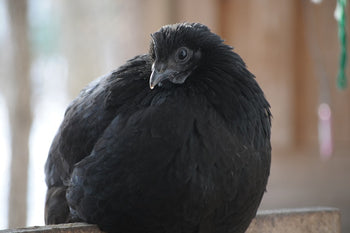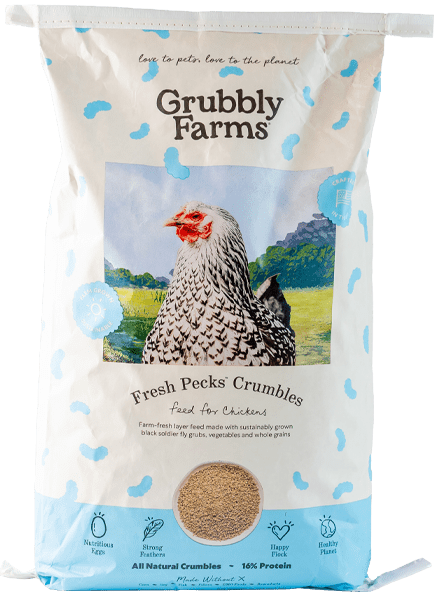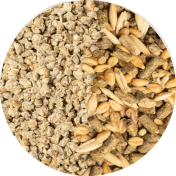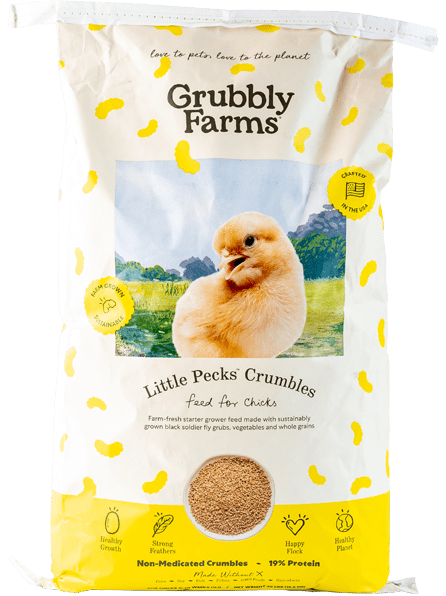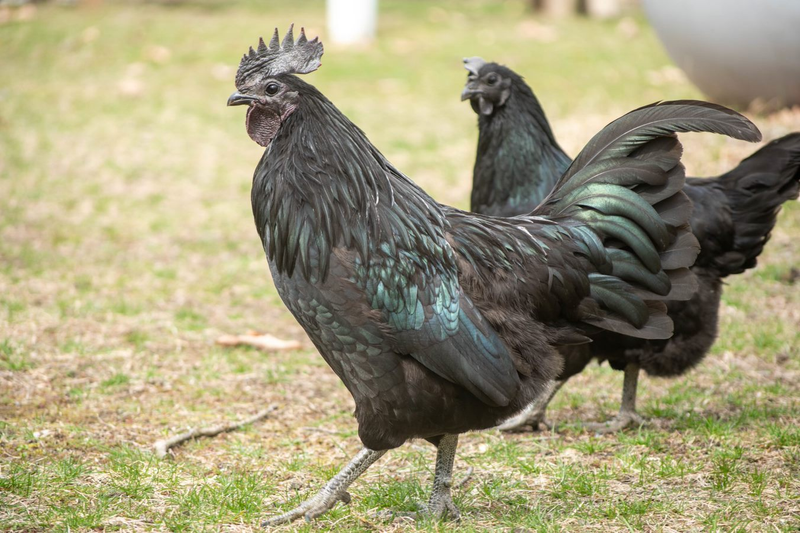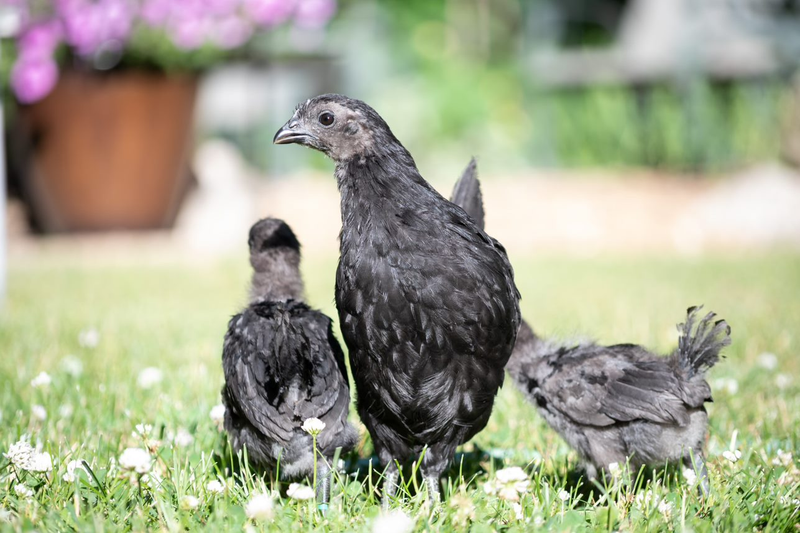Bantams are small, cute, and come in all different breeds and colors! They are a fun addition to any backyard flock and their small size means they eat less, poop less, and require less space than a standard size chicken. However, it’s best to learn all about raising and caring for these mini chickens before deciding to add them to your backyard flock.

What is a Bantam Chicken?
A bantam chicken is a small chicken that is a quarter to a fifth as heavy as a large-fowl chicken. Most bantams weigh less than two pounds and are like a mini version of a standard size chicken. Nearly every large-fowl chicken breed has a bantam counterpart, with the exception of a few breeds. On the flip side, not every bantam breed has a large-fowl counterpart.
To make things more confusing, just because a large-fowl chicken breed has a bantam counterpart doesn’t mean the bantam breed has the same lineage as the large-fowl breed. Some bantam breeds are developed from completely different bloodlines than their large-fowl counterpart, they were just bred to be a smaller look-alike of the breed.
Types of Bantam Chickens
Bantam chicken breeds can be categorized into three different types of bantams: true bantams, miniature bantams, and developed bantams with some bantam breeds overlapping within the three types.
True bantams are bantam breeds that have no large-fowl counterpart. Miniature bantams are bantam breeds that have a large-fowl counterpart. However, they are not true ‘miniatures’ in terms of scale since their head, tail, wings, feathers, and eggs are proportionately larger. Then there are developed bantam breeds, which are bantam breeds that have been created through selective breeding for a specific appearance or function.
Technically, all miniature bantams are developed bantams as well, but not all true bantams are developed bantams. Here are some breed examples for each type of bantam:
- True Bantams: American Game bantam, Bearded d’ Anvers, Bearded d’ Uccle, Booted bantam, Dutch bantam, Nankin, Rosecomb, Sebright, Serama
- Miniature Bantams: Orpington, Polish, Brahma, Plymouth Rock
- Developed Bantams: Belgian, Pekin (Cochin), Japanese
The American Poultry Association (APA) further classifies recognized bantam breeds based on type or physical appearance. Each recognized bantam breed has a breed standard that outlines how every bird in the breed should look in terms of appearance and color (variety).
The APA classifies recognized true bantams, miniature bantams, and developed bantams into the following six classes:
- Modern Game- all modern game bantam types
- Game- Old English Game bantams and American Game bantams
- Single Comb Clean Legged- bantam breeds with a single comb and no feathers on their feet or shanks (Serama, Dutch, Sussex, Orpington)
- Rose Comb Clean Legged- bantam breeds with a rose comb and no feathers on their feet or shanks (Hamburg, Redcap, Sebright, Wyandotte)
- Feather Legged- bantam breeds with feathering on their legs and feet (Booted bantam, Silkie, Brahma, Cochin)
- All Other Comb Clean Legged- bantam breeds that don’t fall into the previous classes (Ameraucana, Polish, Buckeye, Houdan)
In addition to the APA, the American Bantam Association (ABA) was created in 1914 to represent bantam breeders and promote the breeding, showing, and selling of all types of bantams. Some bantam breeds are recognized by the ABA but not by the APA, and vice versa.
There are also different varieties within each breed of bantam. A variety refers to a subdivision of a recognized breed based on plumage color or patterns, comb style, facial feathers, or weight. Variety most often refers to different colors of bantams within a breed. The different varieties that bantam breeds can come in are based on the breed’s standard. Some miniature bantam breeds have different recognized varieties than their large-fowl counterparts.
A few examples of bantam breed varieties include the bantam barred Plymouth Rock, the bantam silver-laced Wyandotte, or the bantam white Silkie.
How to Care for Bantam Chickens
Caring for bantam chickens is pretty much the same as caring for large-fowl chickens, just on a slightly smaller scale. Bantam chicks still have the same brooder needs as standard size chicks. Adult bantams still need a safe and secure coop and a nutritious, balanced diet. Make sure you know how to properly set up a brooder for your bantam chicks and have a safe, secure chicken coop prepared for them once they have matured.
Bantam Coops
Since bantams are smaller than standard size chickens, they don’t require as much space when it comes to making a brooder or building a chicken coop and run. Here are the space requirements for bantam chickens:
- Coop Space: 1-2 square feet per bantam
- Enclosure or Run Space: 2.5-4 square feet per bantam
- Nesting Boxes: 10”x12”x10”
- Roosting Space: 4-6" per bantam
You should supply one nesting box for every four to five bantam hens in your flock. Despite being small, bantam chickens are often excellent flyers, so it’s important to keep roosts raised at least one and half feet to two feet off the ground (with many bantam breeds preferring roosts that are even higher)!
In general, two bantam chickens can be raised in the same amount of space required by one large-fowl chicken. However, the more space you can offer your bantams the better off they will be (including both coop space and enclosure or run space).
Feeding Bantams
When it comes to feeding bantams, bantam chickens eat less food on a daily basis than standard size chickens. In general, you can plan on one bantam chicken eating about one pound of feed per month on a similar diet as standard size chickens. Bantam chicks should be started on chick starter feed and switched to layer feed once they reach laying age (around 20 weeks of age). They should always have access to fresh, clean water. Since bantam chickens are smaller, they often benefit from crumble type feeds or mash feeds, which have smaller feed particles that are easier for small beaks to manage.
You can feed your bantams the same table scraps and treats that are safe for large-fowl chickens too! However, since bantams are smaller, they don’t need as many treats or table scraps as large-fowl chickens. Since they eat less feed on a daily basis, that also means that treats and table scraps should be scaled back proportionately.
Hardiness & Disposition
Please remember bantam chickens are often not as hardy as standard size chickens. They are more sensitive to heat stress and especially cold stress. It is a good idea to choose cold hardy bantam breeds, like Orpingtons or Brahmas, if you live in northern regions that experience cold winters. Likewise, choose heat tolerant bantam breeds, like Leghorns or Polish, if you live in a warm, southern region.
The characteristics and disposition of different bantams will depend on the bantam’s breed. However, most bantam versions of common standard size chicken breeds tend to be more docile, friendly, and calm than their large-fowl counterparts. Some true bantam breeds are known to have more flighty, active dispositions, such as the game bantams who were originally bred for cockfighting. Bantam hens are known to readily go broody and will set on either bantam eggs or standard size chicken eggs! Some breeders keep bantam hens just for the purpose of incubating and hatching eggs from different chicken breeds.
Egg Production
Bantams are slow to reach production maturity. Despite being smaller, they often take longer to reach full maturity than their large-fowl counterparts. Bantam hens may start laying well after they are 20-24 weeks of age. Many bantam breeds are not as productive layers as their large-fowl counterparts. Since bantams are smaller than standard size chickens, that also means that their eggs are smaller. About three bantam eggs equals two standard size chicken eggs. Miniature bantam breeds lay eggs that are slightly larger than true bantam breed eggs. Miniature bantams also tend to lay better than true bantam breeds. True bantam breeds and some developed bantam breeds are usually poor layers and will only lay seasonally in the spring.
Common Q&A’s about Bantam Chickens
How long do bantam chickens live?
The average lifespan of a bantam chicken is 4-8 years. However, under excellent care and with a nutritious diet, many bantams have been known to live upwards of 15 years! Bantam hens will be the most productive during the first 2-3 years of their life. After that their productivity will decline or even stop altogether.
Do bantam chickens lay eggs?
Yes, bantam hens lay eggs. Depending on the breed, bantam hens can lay between 50-200 eggs per year. Miniature bantam breeds are better layers than true bantam breeds. Keep in mind that the eggs you get from your bantam flock will be smaller, so it may require a few more eggs to make yourself a filling omelet for breakfast!
How big do bantam chickens get?
Bantam chickens are generally no larger than two pounds. The smallest bantam breed, the Serama, only weighs 8-16 ounces and has a mature height of around 6” tall. The largest bantam breeds, such as the Brahma or Pekin bantams, weigh 1.5-2.5 pounds and reach a mature height of 10-12" tall.
Can bantams live with big chickens?
Yes, bantam chickens can live with large-fowl chickens. However, if you plan on having a mixed flock of bantam chickens and large-fowl chickens it is best to raise all the birds together right from the brooder. It is harder to integrate the smaller bantams into a large-fowl flock that already has an established pecking order. If you are adding bantams to an established flock of large-fowl chickens, it may be a good idea to have a separate bantam coop for the smaller birds.
When raising bantam chickens and large-fowl chickens together, you will need to make some coop accommodations for the smaller birds. Make sure the feeder and water can be reached by the shorter bantams. Keep the feeder and water at back-level to the shortest bird in your flock. Provide plenty of space and high perches so that the smaller bantams can avoid the larger chickens if necessary.
Bantams may be smaller, but they often have huge attitudes! Many bantams are not afraid to try and boss around their larger flock members. However, it is still a good idea to keep an eye out for bullying of the smaller flock members.
Conclusion:
Bantams are small chickens with big attitudes, practically guaranteed to add character and entertainment to your backyard! If you want to raise bantams with large-fowl chickens, it is best to raise everyone together right from the brooder. Bantams may be smaller, eat less, and poop less, but they still need the same care, loving attention, and nutritious diet as standard size chickens. These fun little birds may be a good fit for your small backyard or suburban flock!





